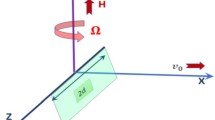Abstract
It is well-known that every two-dimensional porous cavity with a conducting and impermeable boundary is degenerate, as it has two different eigensolutions at the onset of convection. In this paper it is demonstrated that the eigenvalue problem obtained from a linear stability analysis may be reduced to a second-order problem governed by the Helmholtz equation, after separating out a Fourier component. This separated Fourier component implies a constant wavelength of disturbance at the onset of convection, although the phase remains arbitrary. The Helmholtz equation governs the critical Rayleigh number, and makes it independent of the orientation of the porous cavity. Finite-difference solutions of the eigenvalue problem for the onset of convection are presented for various geometries. Comparisons are made with the known solutions for a rectangle and a circle, and analytical solutions of the Helmholtz equation are given for many different domains.
Similar content being viewed by others
References
C.W. Horton and F.T. Rogers, Convection currents in a porous medium. J. Appl. Phys. 16 (1945) 367-370.
E.R. Lapwood, Convection of a fluid in a porous medium. Proc. Camb. Phil. Soc. 44 (1948) 508-521.
D.A. Nield, Onset of thermohaline convection in a porous medium. Water Resources Res. 11 (1968) 553-560.
D.A. Nield and A. Bejan, Convection in Porous Media (2nd edition). New York: Springer (1999) 546 pp.
J.L. Beck, Convection in a box of porous material saturated with fluid. Phys. Fluids, 15 (1972) 1377-1383.
T. Nilsen and L. Storesletten, An analytical study on natural-convection in isotropic and anisotropic porous channels. Trans. A.S.M.E. J. Heat Transfer 112 (1990) 396-401.
D.A.S. Rees and J.L. Lage, The effect of thermal stratification on natural convection in a vertical porous insulation layer. Int. J. Heat Mass Transfer 40 (1997) 111-121.
D.V. Lyubimov, Convective motions in a porous medium heated from below. J. Appl. Mech. Techn. Phys. 16 (1975) 257-261.
D.A. Bratsun, D.V. Lyubimov and B. Roux, Co-symmetry breakdown in problems of thermal convection in porous medium. Physica D 82 (1995) 398-417.
L. Storesletten and M. Tveitereid, Natural convection in a horizontal porous cylinder. Int. J. Heat Mass Transfer 34 (1991) 1959-1968.
A. Jennings and J.J. McKeown, Matrix Computation (2nd Edition). Wiley (1992) 427 pp.
W.L. Briggs, V.E. Henson and S.F. McCormick, A Multigrid Tutorial (2nd Edition). Philadelphia: S.I.A.M. (2000) 193 pp.
R. Courant and D. Hilbert, Methods of Mathematical Physics Volume 1 (2nd Edition). New York: Wiley (1953) 560 pp.
G.M.L. Gladwell and N.B. Willms, On the mode shapes of the Helmholtz equation. J. Sound Vibration 188 (1995) 419-433.
Author information
Authors and Affiliations
Rights and permissions
About this article
Cite this article
Rees, D.A., Tyvand, P.A. The Helmholtz equation for convection in two-dimensional porous cavities with conducting boundaries. Journal of Engineering Mathematics 49, 181–193 (2004). https://doi.org/10.1023/B:ENGI.0000017494.18537.df
Issue Date:
DOI: https://doi.org/10.1023/B:ENGI.0000017494.18537.df




